Synergistic Evaluation of Passive Microwave and Optical/IR Data for Modelling Vegetation Transmissivity towards Improved Soil Moisture Retrieval
Abstract
:1. Introduction
2. Study Area and Datasets
2.1. Study Area
2.2. Satellite Datasets
2.3. Ground Datasets
3. Methods
3.1. Baseline Algorithm
3.2. Algorithm Improvement
3.2.1. VWC Index Extraction
3.2.2. Transmissivity Modelling
Linear, First Order
Nonlinear, Exponential
4. Results and Discussion
5. Conclusions
Author Contributions
Funding
Institutional Review Board Statement
Informed Consent Statement
Data Availability Statement
Acknowledgments
Conflicts of Interest
References
- Sun, F.; Lü, Y.; Wang, J.; Hu, J.; Fu, B. Soil moisture dynamics of typical ecosystems in response to precipitation: A monitoring-based analysis of hydrological service in the Qilian Mountains. Catena 2015, 129, 63–75. [Google Scholar] [CrossRef]
- Entekhabi, D.; Reichle, R.H.; Koster, R.D.; Crow, W.T. Performance metrics for soil moisture retrievals and application requirements. J. Hydrometeorol. 2010, 11, 832–840. [Google Scholar] [CrossRef]
- Walker, J.P.; Houser, P.R. Requirements of a global near-surface soil moisture satellite mission: Accuracy, repeat time, and spatial resolution. Adv. Water Resour. 2004, 27, 785–801. [Google Scholar] [CrossRef]
- Srivastava, P.K. Satellite soil moisture: Review of theory and applications in water resources. Water Resour. Manag. 2017, 31, 3161–3176. [Google Scholar] [CrossRef]
- Chanzy, A. Basic soil surface characteristics derived from active microwave remote sensing. Remote Sens. Rev. 1993, 7, 303–319. [Google Scholar] [CrossRef]
- Li, Q.; Zhong, R.; Huang, J.; Gong, H. Comparison of two retrieval methods with combined passive and active microwave remote sensing observations for soil moisture. Math. Comput. Model. 2011, 54, 1181–1193. [Google Scholar] [CrossRef]
- Njoku, E.G.; Chan, S.K. Vegetation and surface roughness effects on AMSR-E land observations. Remote Sens. Environ. 2006, 100, 190–199. [Google Scholar] [CrossRef]
- Colliander, A.; Chan, S.; Kim, S.-b.; Das, N.; Yueh, S.; Cosh, M.; Bindlish, R.; Jackson, T.; Njoku, E. Long term analysis of PALS soil moisture campaign measurements for global soil moisture algorithm development. Remote Sens. Environ. 2012, 121, 309–322. [Google Scholar] [CrossRef]
- Srivastava, P.K.; Han, D.; Ramirez, M.A.; O’Neill, P.; Islam, T.; Gupta, M. Assessment of SMOS soil moisture retrieval parameters using tau-omega algorithms for soil moisture deficit estimation. J. Hydrol. 2014, 519, 574–587. [Google Scholar] [CrossRef] [Green Version]
- Gao, Z.; Xu, X.; Wang, J.; Yang, H.; Huang, W.; Feng, H. A method of estimating soil moisture based on the linear decomposition of mixture pixels. Math. Comput. Model. 2013, 58, 606–613. [Google Scholar] [CrossRef]
- Owe, M.; de Jeu, R.; Walker, J. A methodology for surface soil moisture and vegetation optical depth retrieval using the microwave polarization difference index. IEEE Trans. Geosci. Remote Sens. 2001, 39, 1643–1654. [Google Scholar] [CrossRef] [Green Version]
- Santi, E.; Pettinato, S.; Paloscia, S.; Pampaloni, P.; Macelloni, G.; Brogioni, M. An algorithm for generating soil moisture and snow depth maps from microwave spaceborne radiometers: HydroAlgo. Hydrol. Earth Syst. Sci. 2012, 16, 3659–3676. [Google Scholar] [CrossRef] [Green Version]
- El Hajj, M.; Baghdadi, N.; Bazzi, H.; Zribi, M. Penetration analysis of SAR signals in the C and L bands for wheat, maize, and grasslands. Remote Sens. 2019, 11, 31. [Google Scholar] [CrossRef] [Green Version]
- Petropoulos, G.; Srivastava, P.K.; Ferentinos, K.P.; Hristopoulos, D. Evaluating the capabilities of optical/TIR imaging sensing systems for quantifying soil water content. Geocarto Int. 2020, 35, 494–511. [Google Scholar] [CrossRef]
- Yang, S.; Shen, S.; Li, B.; Le Toan, T.; He, W. Rice mapping and monitoring using ENVISAT ASAR data. IEEE Geosci. Remote Sens. Lett. 2008, 5, 108–112. [Google Scholar] [CrossRef]
- Moradizadeh, M.; Saradjian, M.R. The effect of roughness in simultaneously retrieval of land surface parameters. Phys. Chem. Earth Parts A/B/C 2016, 94, 127–135. [Google Scholar] [CrossRef]
- Mojiri, A.; Jalalian, A. Relationship between growth of Nitraria schoberi and some soil properties. J. Anim. Plant Sci. 2011, 21, 246–250. [Google Scholar]
- Dobson, M.C.; Ulaby, F.T.; Hallikainen, M.T.; El-Rayes, M.A. Microwave dielectric behavior of wet soil-Part II: Dielectric mixing models. IEEE Trans. Geosci. Remote Sens. 1985, GE-23, 35–46. [Google Scholar]
- Shi, J.; Jiang, L.; Zhang, L.; Chen, K.-S.; Wigneron, J.-P.; Chanzy, A. A parameterized multifrequency-polarization surface emission model. IEEE Trans. Geosci. Remote Sens. 2005, 43, 2831–2841. [Google Scholar]
- Gao, B.-C. NDWI—A normalized difference water index for remote sensing of vegetation liquid water from space. Remote Sens. Environ. 1996, 58, 257–266. [Google Scholar] [CrossRef]
- Saradjian, M.; Hosseini, M. Soil moisture estimation by using multipolarization SAR image. Adv. Space Res. 2011, 48, 278–286. [Google Scholar] [CrossRef]
- Zhao, T.; Shi, J.; Bindlish, R.; Jackson, T.; Cosh, M.; Jiang, L.; Zhang, Z.; Lan, H. Parametric exponentially correlated surface emission model for L-band passive microwave soil moisture retrieval. Phys. Chem. Earth Parts A/B/C 2015, 83, 65–74. [Google Scholar] [CrossRef]
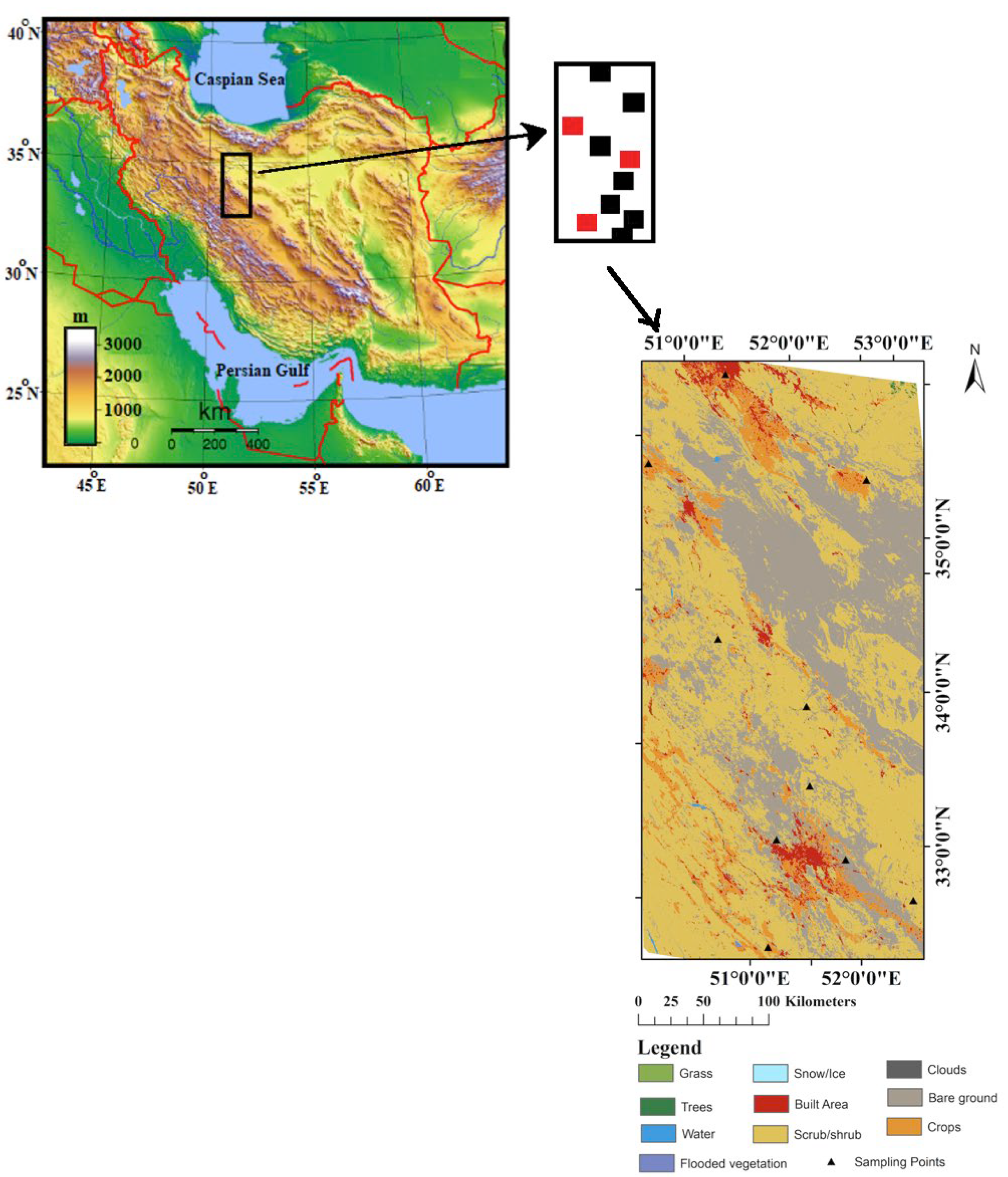
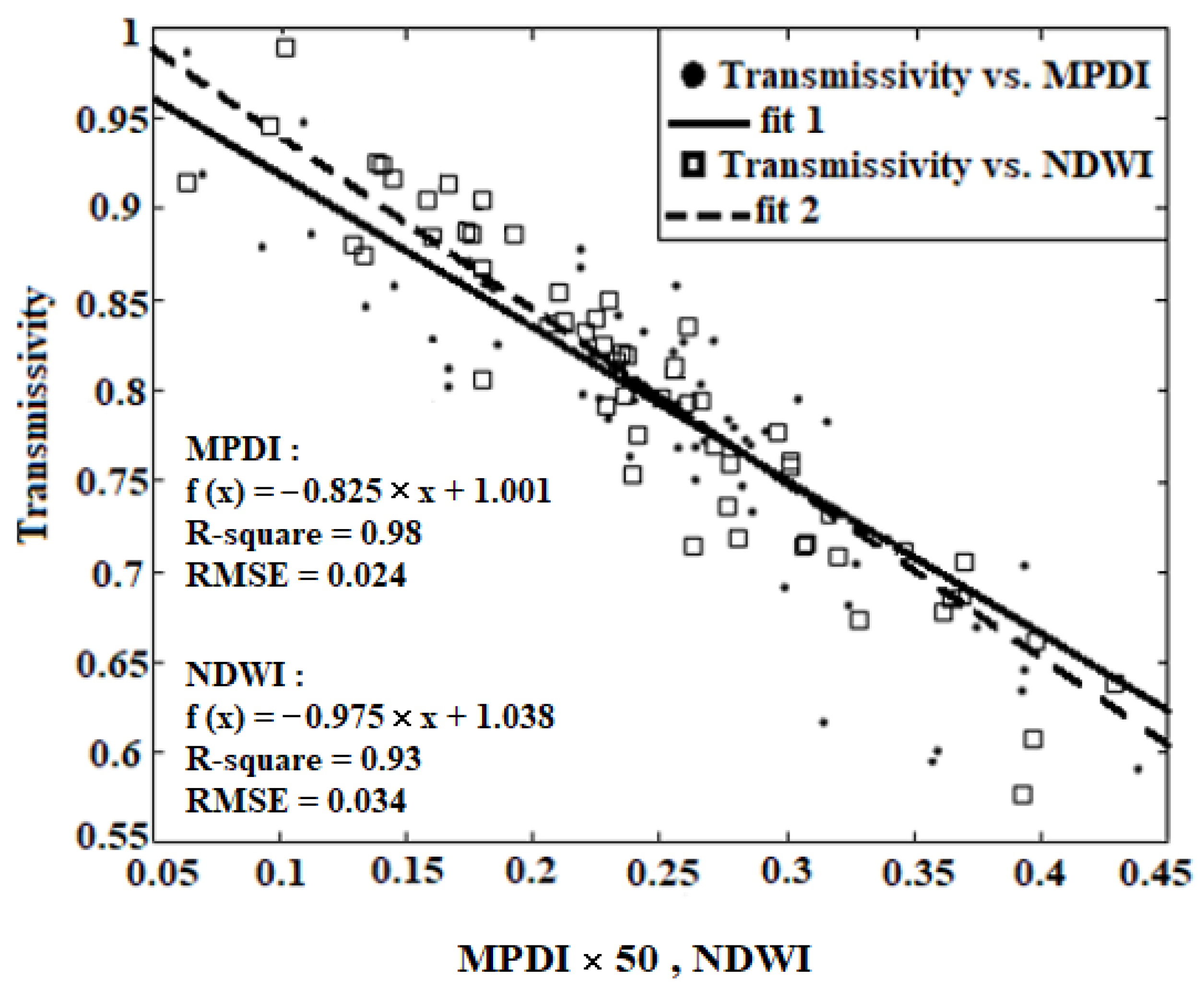
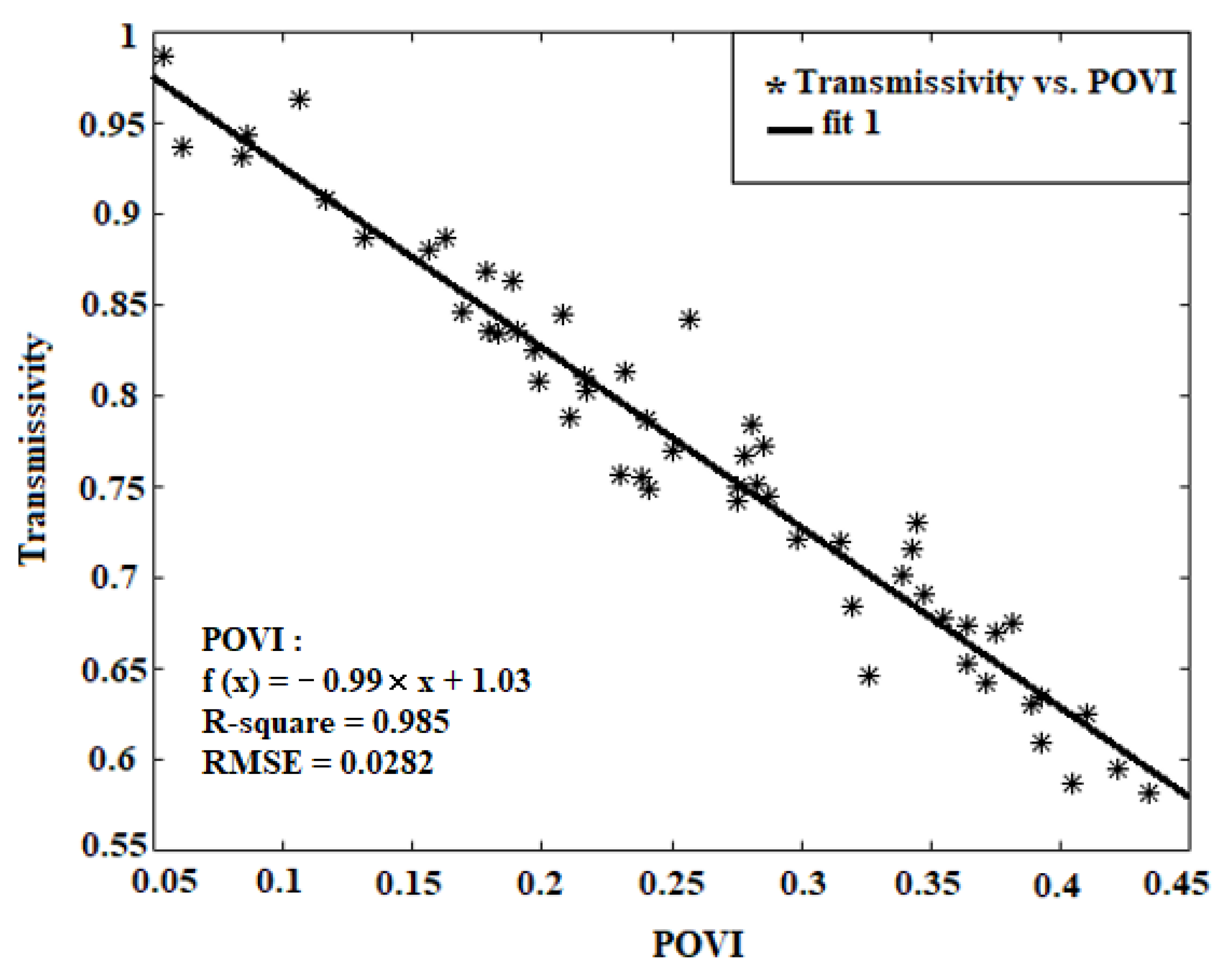
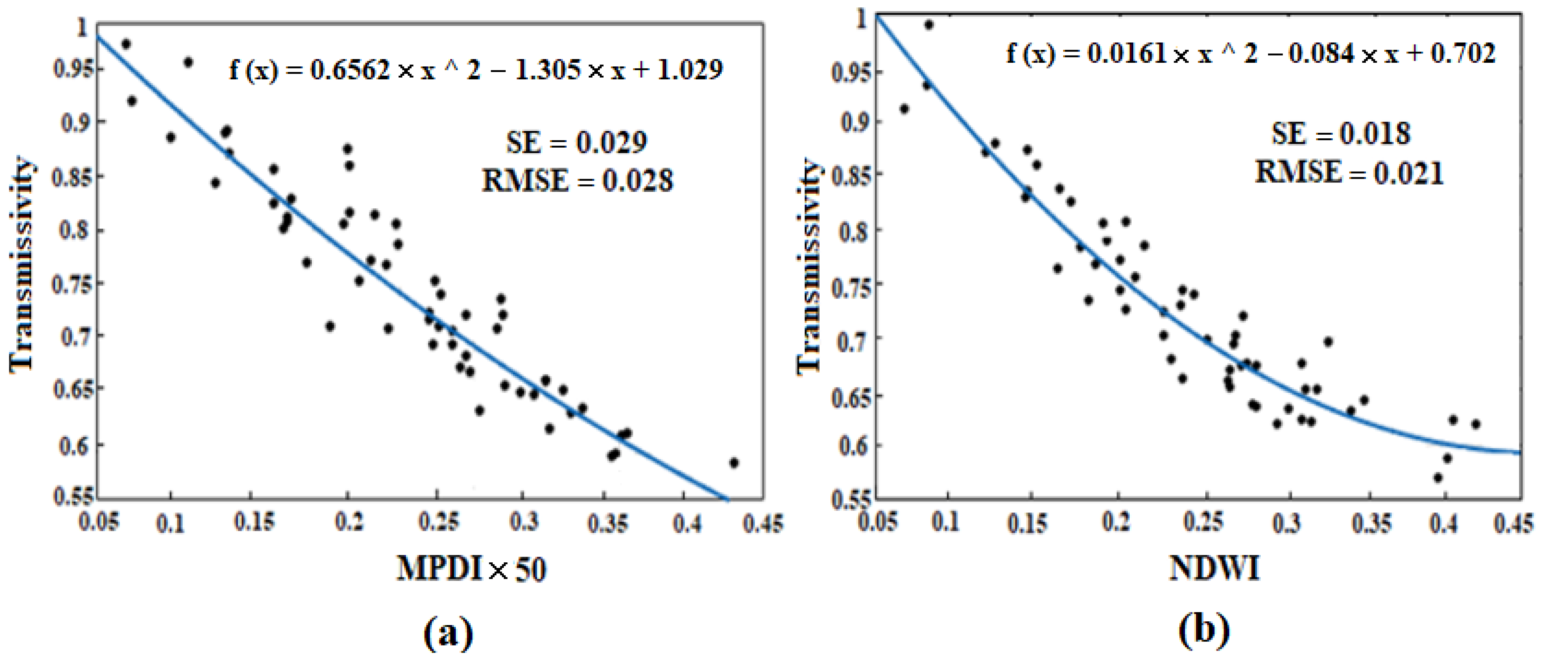
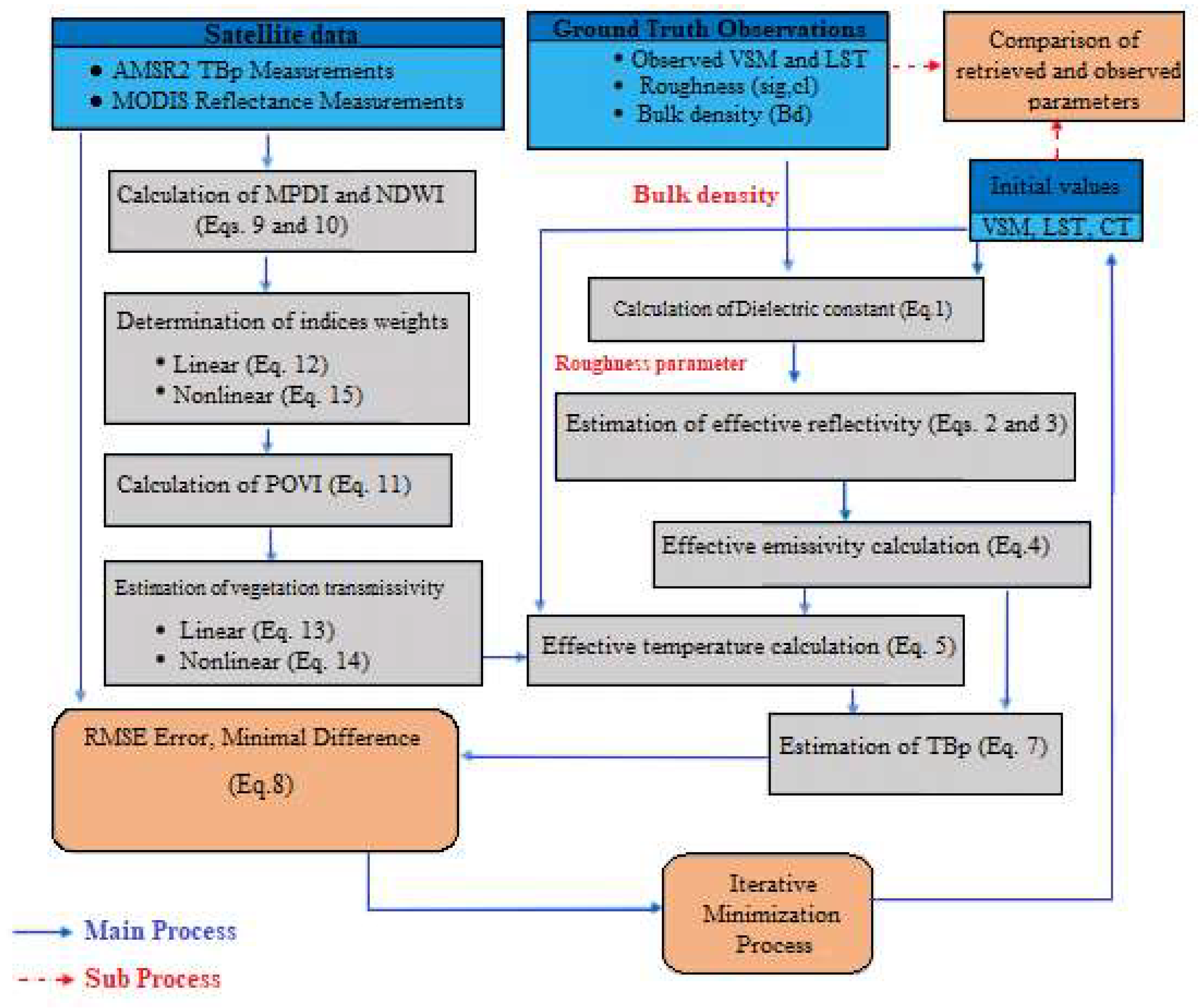
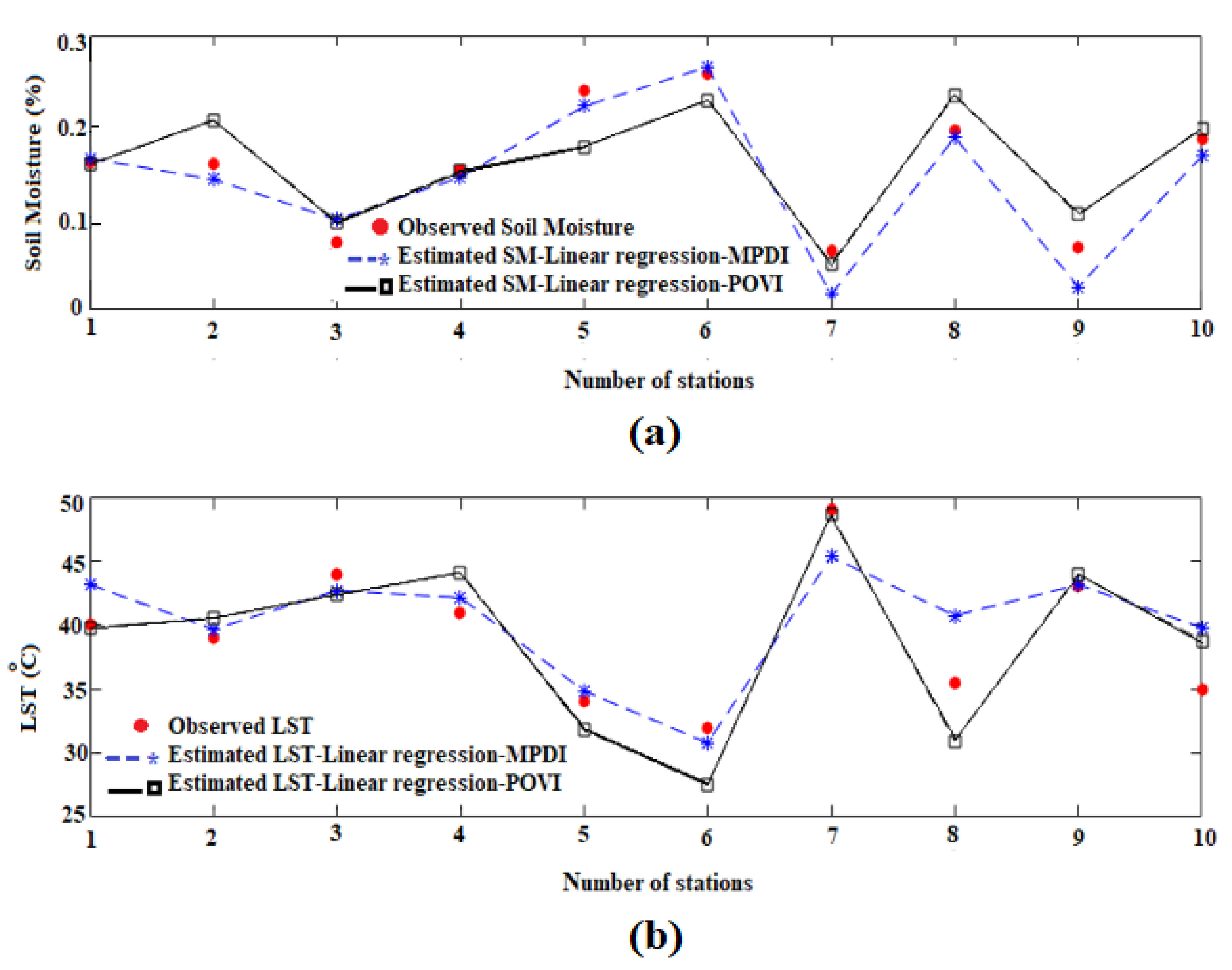
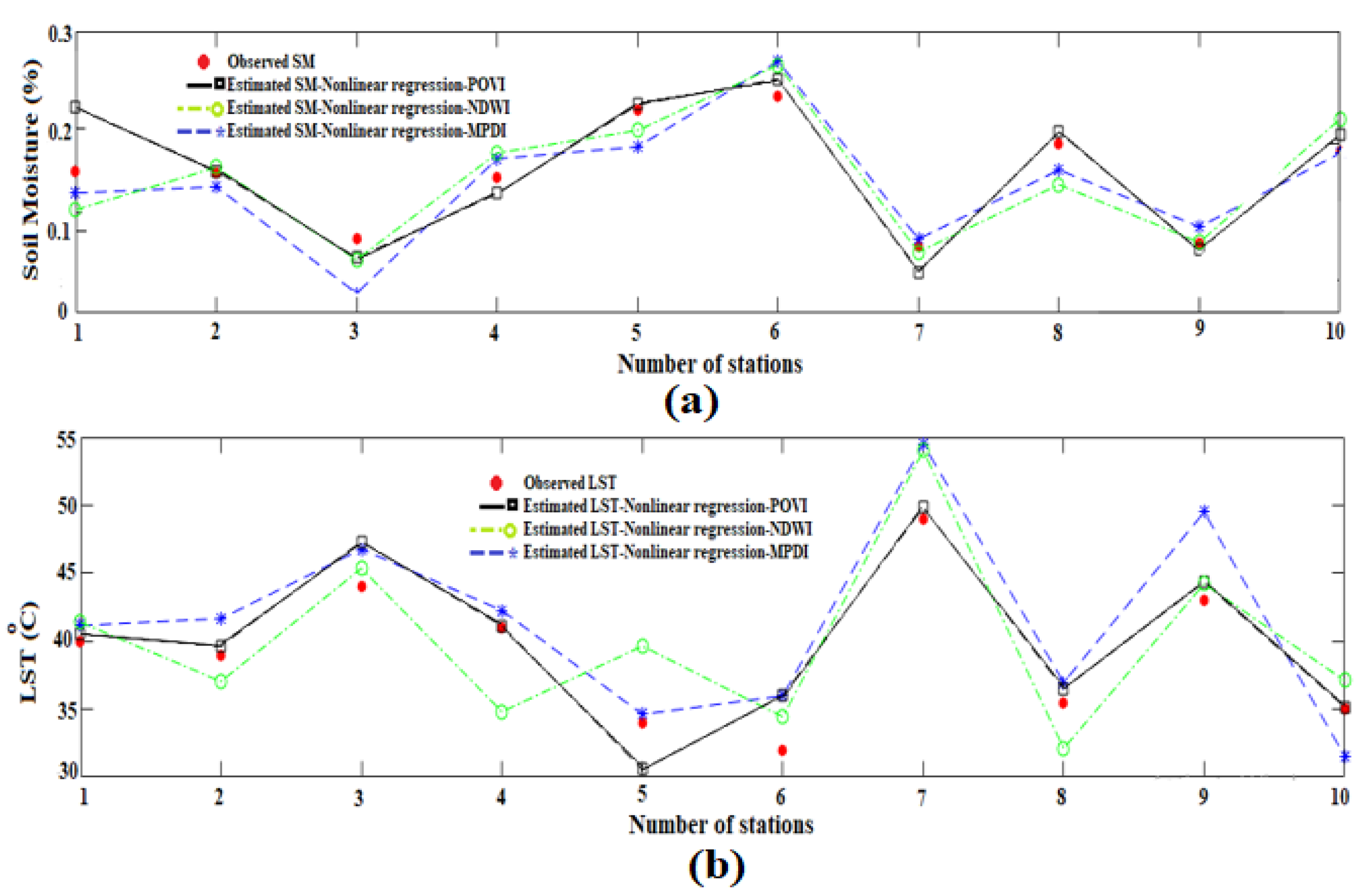
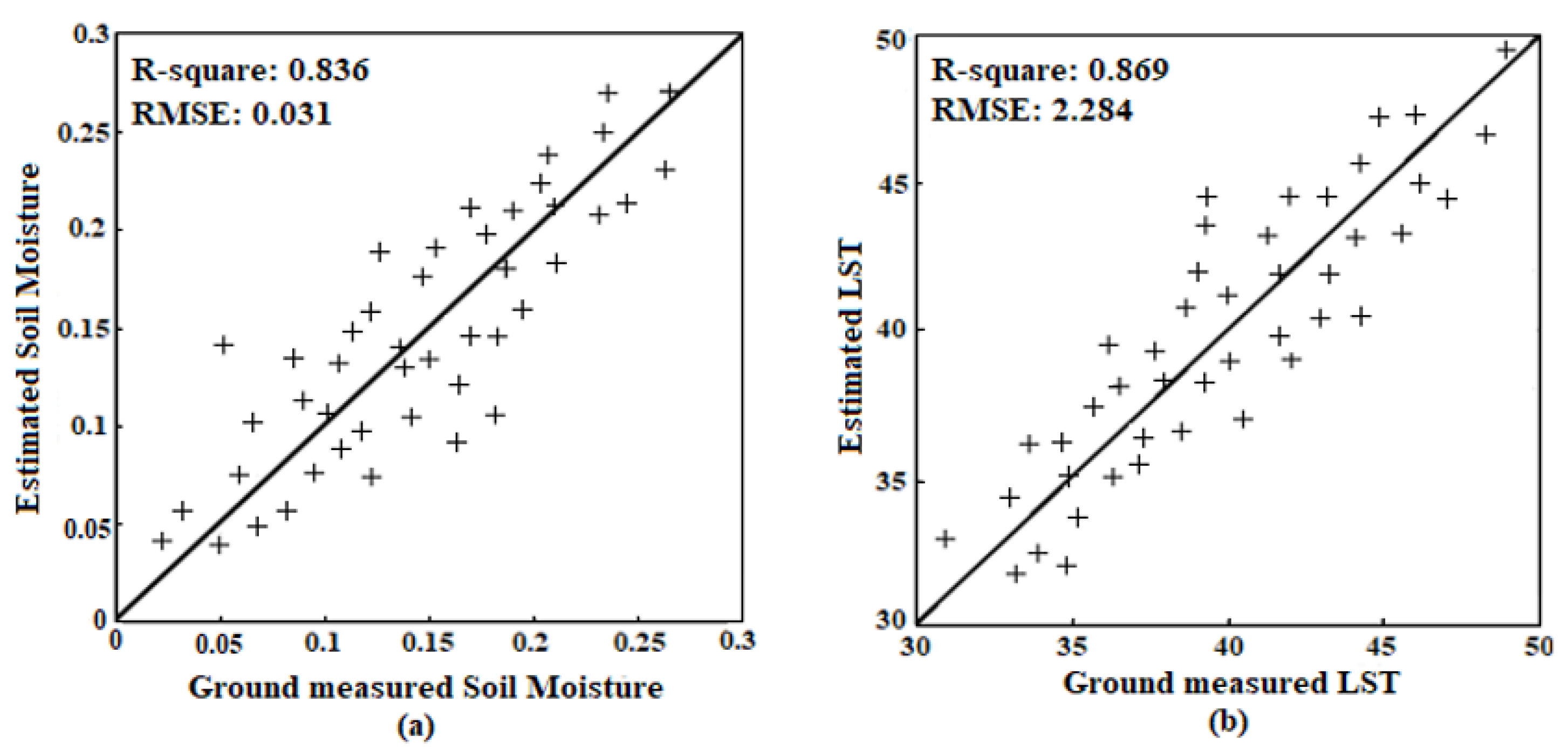
| Source | Used Channels | Spatial Resolution | Temporal Resolution | Purpose |
|---|---|---|---|---|
| AMSR2/GCOM-W | 6.9, 10.65 and 18.7 GHz (v and h polarizations) | 25 km | Daily | VSM, LST and TC retrieval |
| AMSR2/GCOM-W | 36.5 GHz (v and h polarizations) | 25 km | Daily | Derivation of MPDI (calculation of vegetation water content) |
| MODIS/Aqua | Band 2 (850 nm, NIR), Band 5 (1240 nm, SWIR) | 1 km | Daily | Calculation of NDWI |
| Regression Type | Parameters | Coefficients | Type of INDEX | RMSE VSM (m3/m3) | RMSE LST (°C) |
|---|---|---|---|---|---|
| Linear regression | a = −0.041 | w1 = 1, w2 = 0 | MPDI | 0.042 | 2.92 |
| b = 0.984 | w1 = 0.513, w2 = 0.486 | POVI | 0.044 | 3.03 | |
| Nonlinear regression | a = 100 | w1 = 0.38, w2 = 0.62 | POVI | 0.031 | 2.28 |
| w1 = 0, w2 = 1 | NDWI | 0.033 | 2.32 | ||
| w1 = 1, w2 = 0 | MPDI | 0.038 | 2.81 |
Publisher’s Note: MDPI stays neutral with regard to jurisdictional claims in published maps and institutional affiliations. |
© 2022 by the authors. Licensee MDPI, Basel, Switzerland. This article is an open access article distributed under the terms and conditions of the Creative Commons Attribution (CC BY) license (https://creativecommons.org/licenses/by/4.0/).
Share and Cite
Moradizadeh, M.; Srivastava, P.K.; Petropoulos, G.P. Synergistic Evaluation of Passive Microwave and Optical/IR Data for Modelling Vegetation Transmissivity towards Improved Soil Moisture Retrieval. Sensors 2022, 22, 1354. https://doi.org/10.3390/s22041354
Moradizadeh M, Srivastava PK, Petropoulos GP. Synergistic Evaluation of Passive Microwave and Optical/IR Data for Modelling Vegetation Transmissivity towards Improved Soil Moisture Retrieval. Sensors. 2022; 22(4):1354. https://doi.org/10.3390/s22041354
Chicago/Turabian StyleMoradizadeh, Mina, Prashant K. Srivastava, and George P. Petropoulos. 2022. "Synergistic Evaluation of Passive Microwave and Optical/IR Data for Modelling Vegetation Transmissivity towards Improved Soil Moisture Retrieval" Sensors 22, no. 4: 1354. https://doi.org/10.3390/s22041354
APA StyleMoradizadeh, M., Srivastava, P. K., & Petropoulos, G. P. (2022). Synergistic Evaluation of Passive Microwave and Optical/IR Data for Modelling Vegetation Transmissivity towards Improved Soil Moisture Retrieval. Sensors, 22(4), 1354. https://doi.org/10.3390/s22041354







